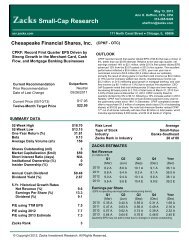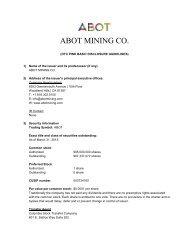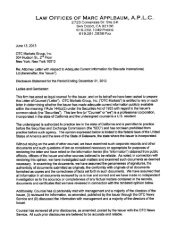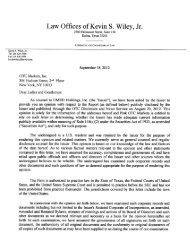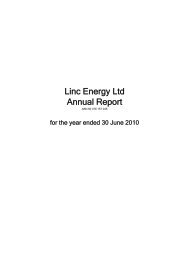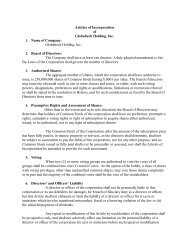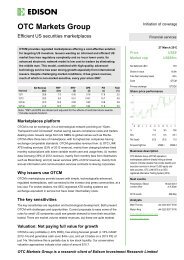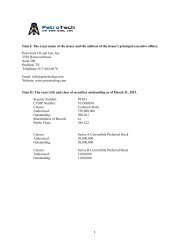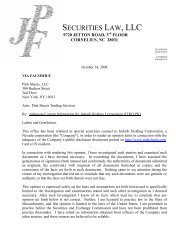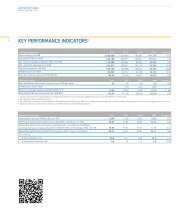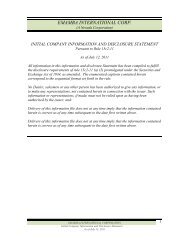2013 Apr 15 Annual Report 2012 - Phosphagenics
2013 Apr 15 Annual Report 2012 - Phosphagenics
2013 Apr 15 Annual Report 2012 - Phosphagenics
You also want an ePaper? Increase the reach of your titles
YUMPU automatically turns print PDFs into web optimized ePapers that Google loves.
Notes to the consolidated fi nancial statements<br />
2. SUMMARY OF SIGNIFICANT ACCOUNTING POLICIES (CONTINUED)<br />
(c) Basis of consolidation<br />
The consolidated fi nancial statements comprise the fi nancial statements of <strong>Phosphagenics</strong> Limited<br />
and its subsidiaries as at and for the period ended 31 December each year (‘the Group’).<br />
Subsidiaries are all those entities over which the Group has the power to govern the fi nancial and<br />
operating policies so as to obtain benefi ts from their activities. The existence and effect of potential<br />
voting rights that are currently exercisable or convertible are considered when assessing whether a group<br />
controls another entity.<br />
The fi nancial statements of subsidiaries are prepared for the same reporting period as the parent<br />
company, using consistent accounting policies.<br />
In preparing the consolidated fi nancial statements, all intercompany balances and transactions, income<br />
and expenses and profi t and losses resulting from intra-group transactions have been eliminated in full.<br />
Investments in subsidiaries held by <strong>Phosphagenics</strong> Limited are accounted for at cost in the separate<br />
fi nancial statements of the parent entity less any impairment charges.<br />
(d) Operating Segments<br />
78<br />
An operating segment is a component of an entity that engages in business activities from which it may<br />
earn revenues and incur expenses (including revenues and expenses relating to transactions with other<br />
components of the same entity), whose operating results are regularly reviewed by the entity’s chief<br />
operating decision maker to make decisions about resources to be allocated to the segment and assess<br />
its performance and for which discrete fi nancial information is available. Management will also consider<br />
other factors in determining operating segments such as the existence of a line manager and the level<br />
of segment information presented to the board of directors.<br />
Operating segments that meet the quantitative criteria as prescribed by AASB 8 are reported separately.<br />
However, an operating segment that does not meet the quantitative criteria is still reporting separately<br />
where information about the segment would be useful to users of the fi nancial statements.<br />
Information about other business activities and operating segments that are below the quantitative criteria<br />
are combined and disclosed in a separate category for “all other segments”.<br />
(e) Significant accounting judgements, estimates and assumptions<br />
The carrying amounts of certain assets and liabilities are often determined based on estimates and<br />
assumptions of future events. The key estimates and assumptions that have a signifi cant risk of causing<br />
a material adjustment to the carrying amounts of certain assets and liabilities within the next annual<br />
reporting period are:<br />
Impairment of intangibles with indefinite useful lives<br />
The Group determines whether intangible assets with indefi nite useful lives, and intangible assets<br />
not yet available for use, are impaired at least on an annual basis. This requires an estimation of the<br />
recoverable amount of the cashgenerating unit to which the goodwill is allocated. The assumptions used<br />
in this estimation of recoverable amount and the carrying amount of intangibles with indefi nite useful lives<br />
are discussed in note 10.<br />
During the reporting period, certain intangible assets previously assessed as having indefi nite useful lives<br />
were reassessed as having fi nite useful lives. As such these intangible assets have begun being amortised<br />
over the remaining expiry period of the patents.<br />
Share-based payment transactions<br />
The Group measures the cost of equity-settled transactions with employees by reference to the fair value<br />
of the equity instruments at the date at which they are granted. The fair value is determined by using the<br />
Binomial method taking into account the terms and conditions upon which the instruments were granted,<br />
as discussed in note 5. The accounting estimates and assumptions relating to equity-settled share-based<br />
payments would have no impact on the carrying amounts of assets and liabilities with the next annual<br />
reporting period but may impact expenses and equity.<br />
PHOSPHAGENICS ANNUAL REPORT <strong>2012</strong>



